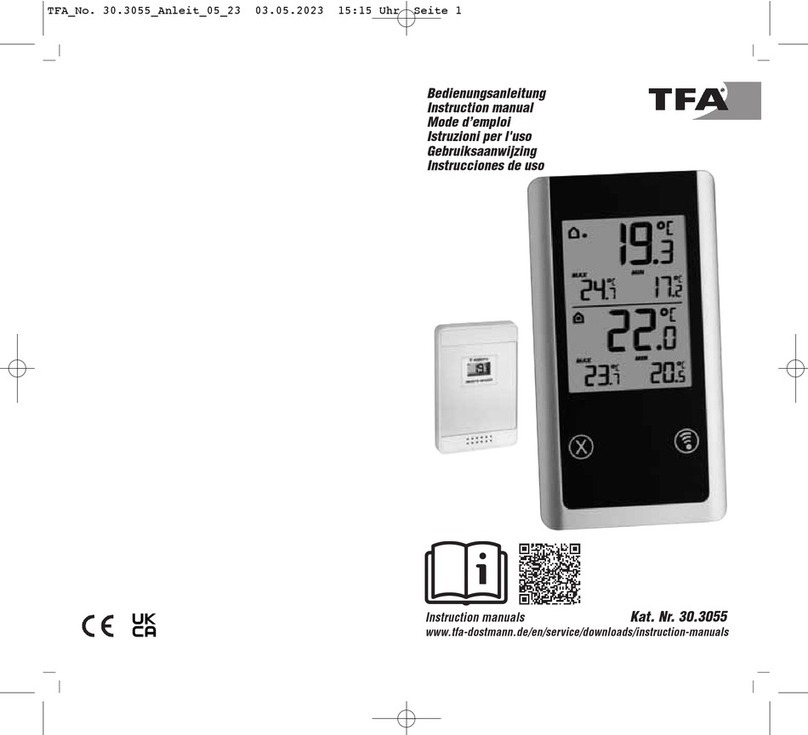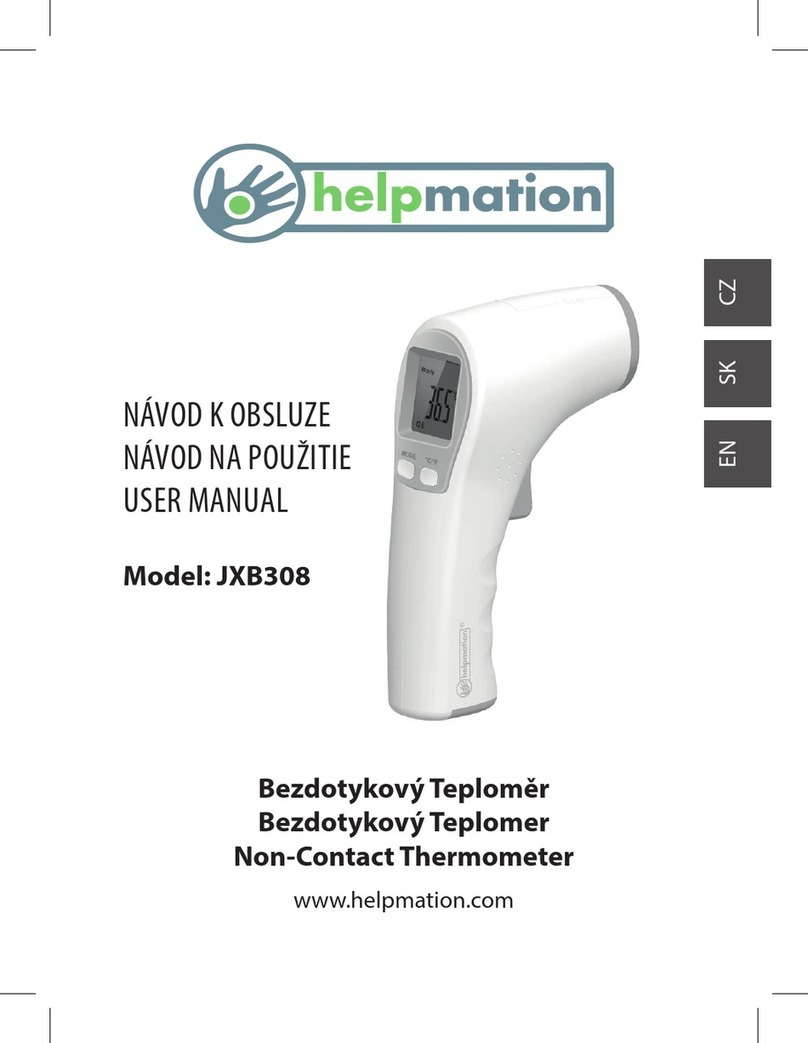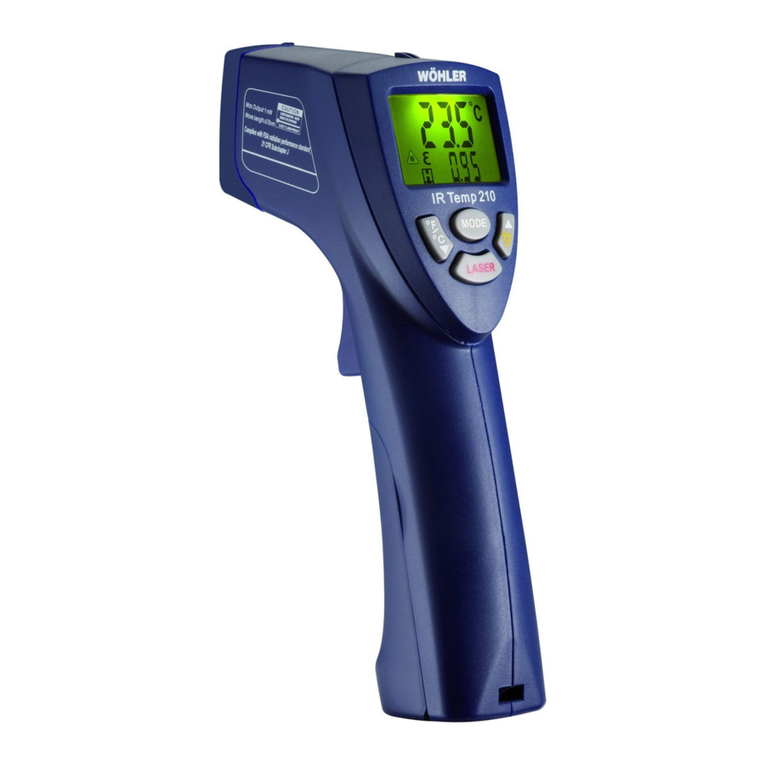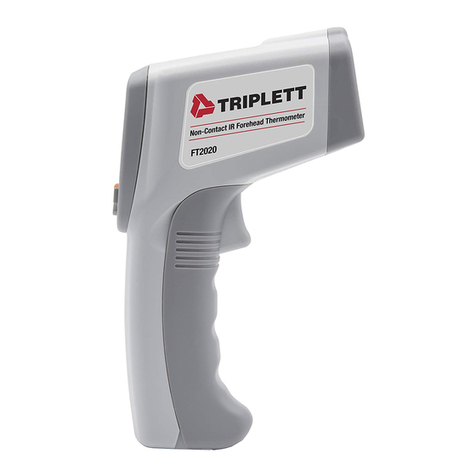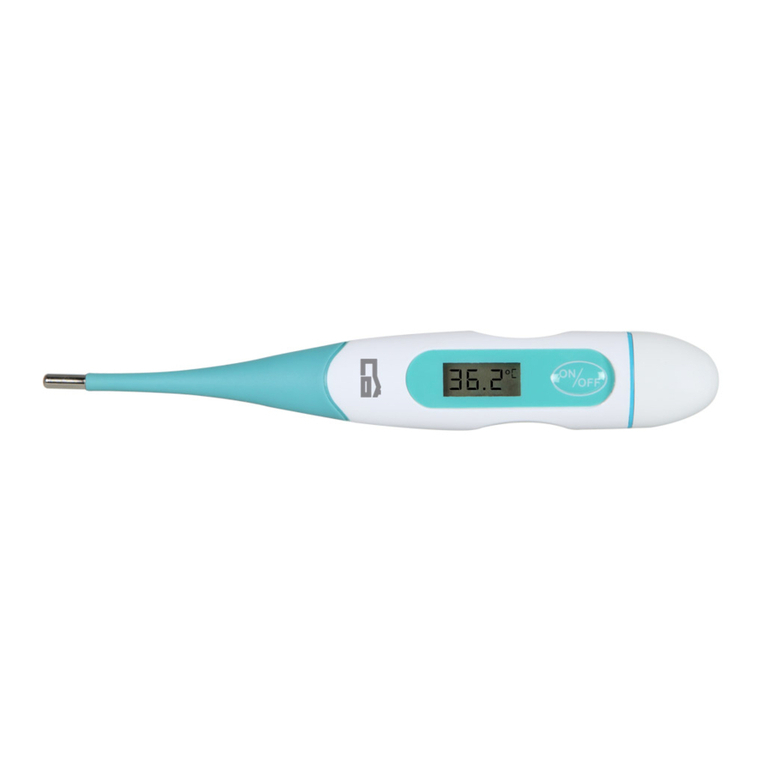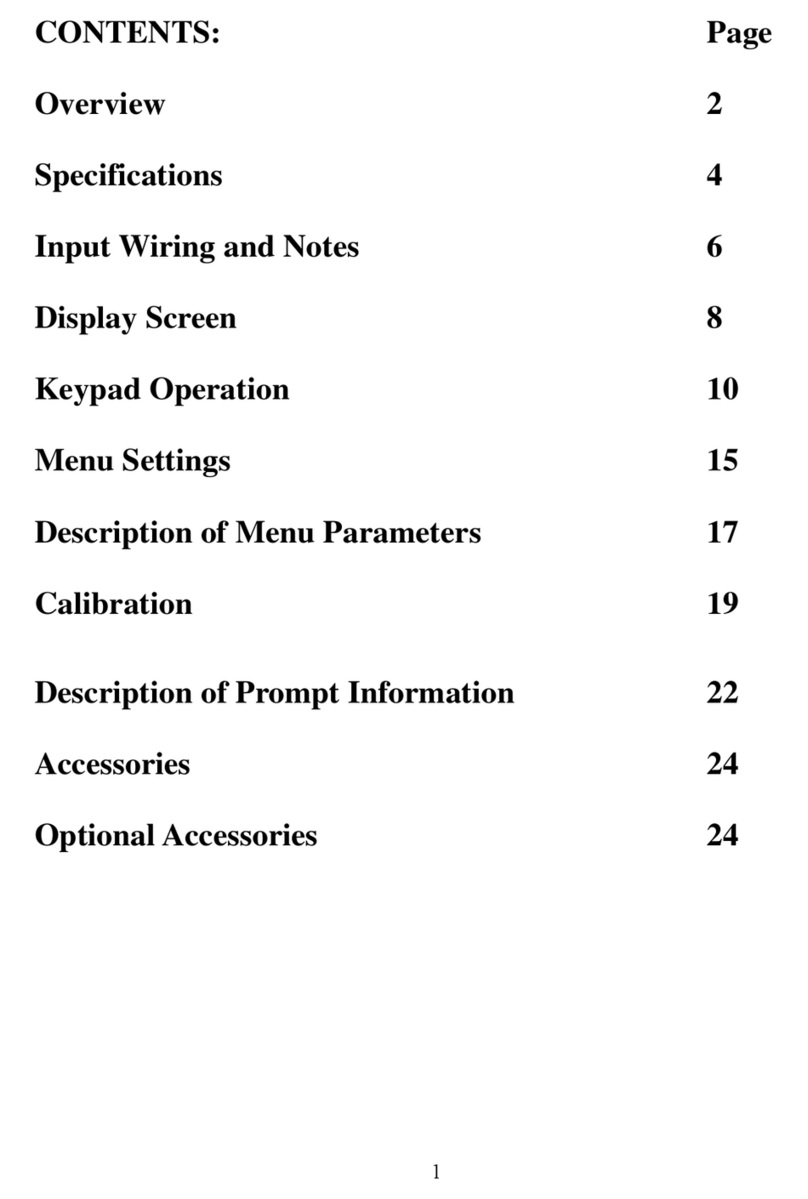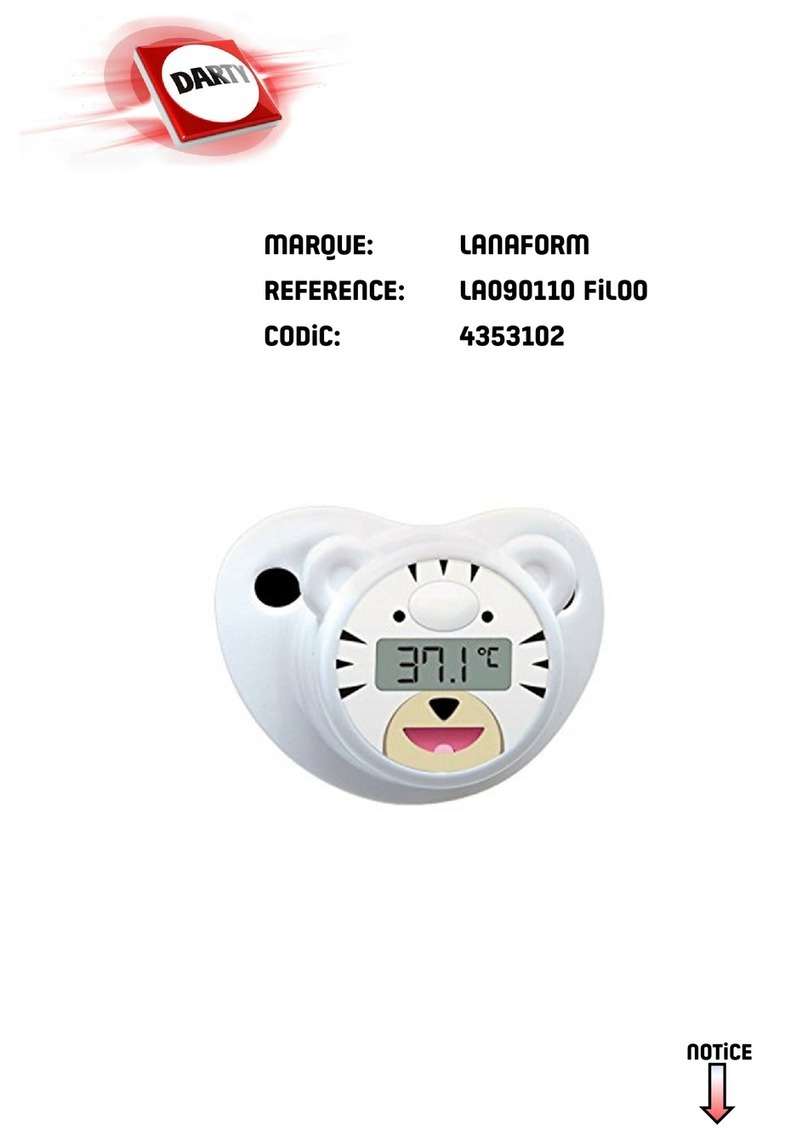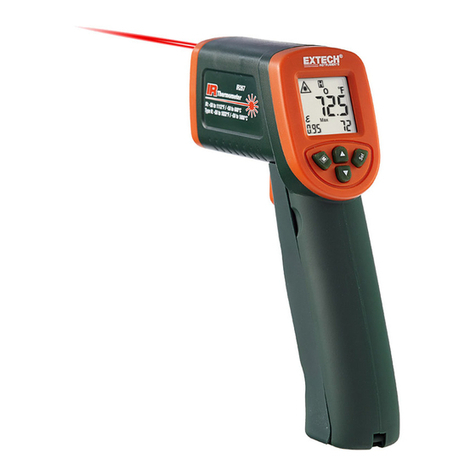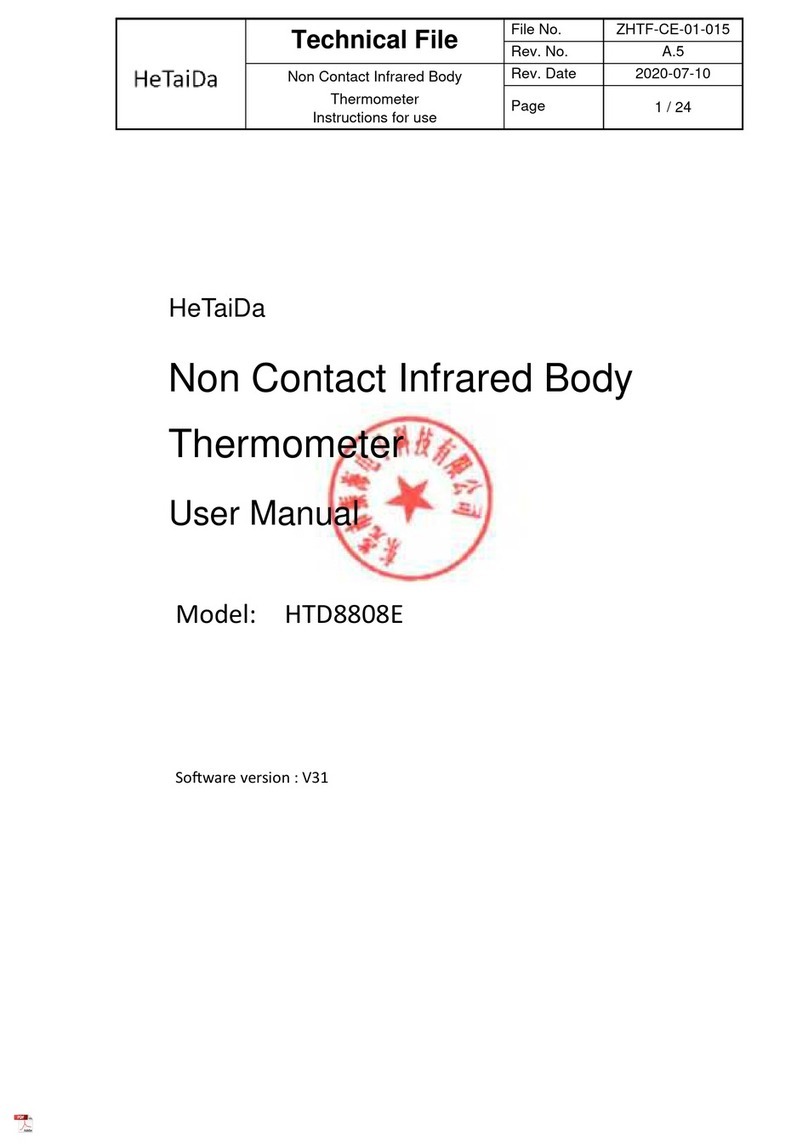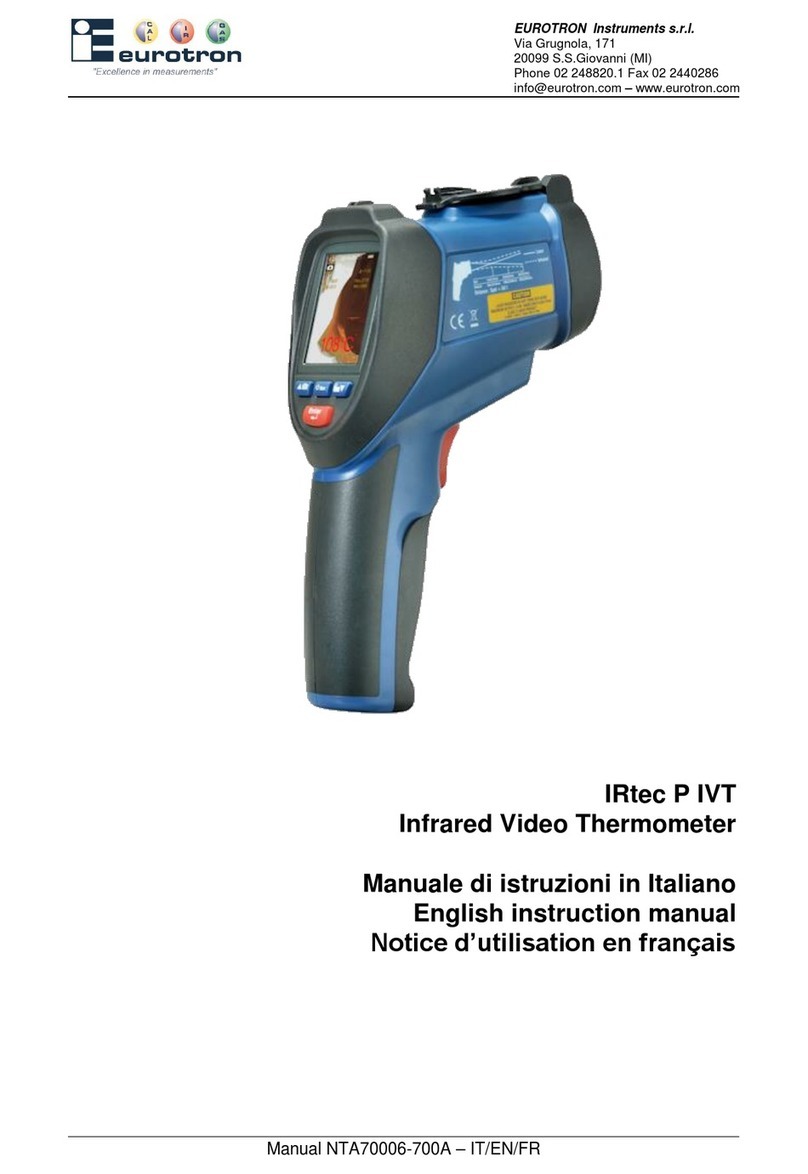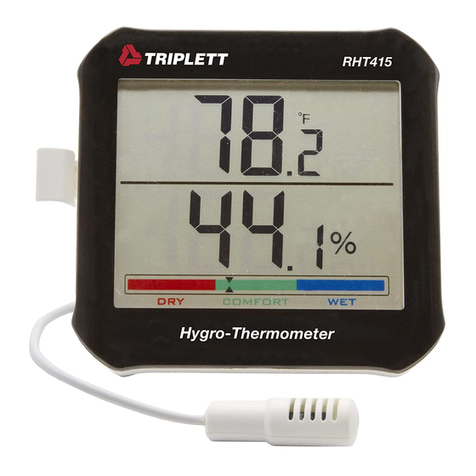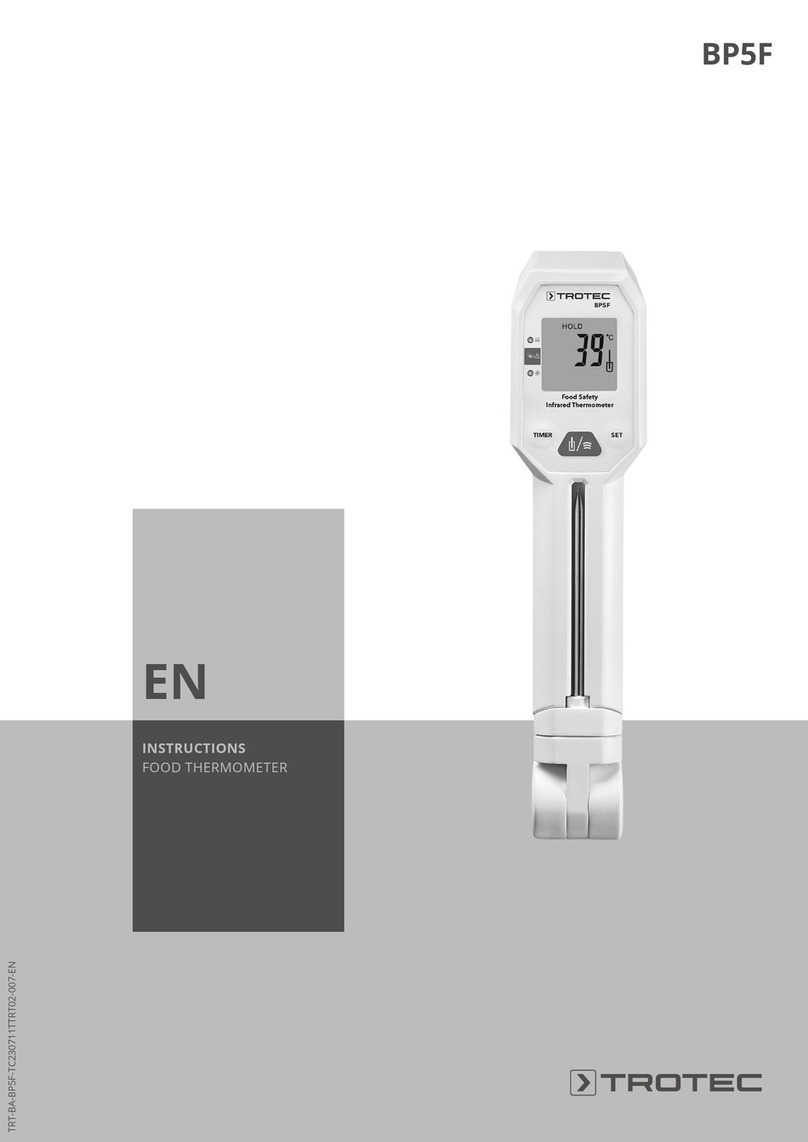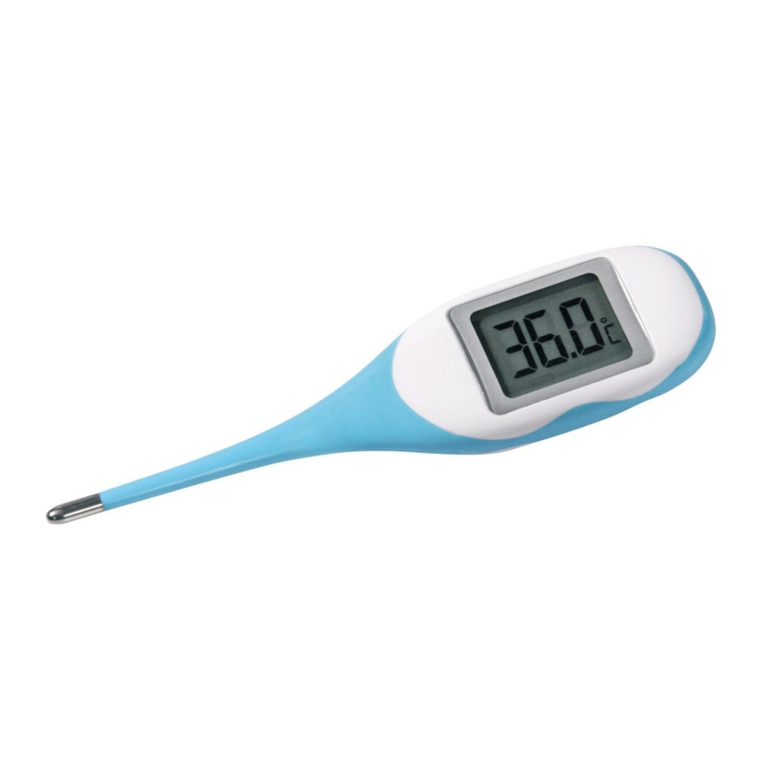innovu health INH-GB-01 User manual

®
HEALTH
NON-CONTACT
INFRARED THERMOMETER
INH-GB-01
USER
MANUAL
innovuhealth.co

Introduction
Product Intended use
Attentions & notes
Principle
Product Features
Technical Parameters
Shape Structure
Display Icon Definition
Function Keys
Settings
Measuring Method
Forehead temperature measurements
Ear temperature measurement
Object temperature measurement
Replacing Batteries
Maintenance & Cleaning
Troubleshooting
EMC Information
2
2
2
3
3
3
4
4
5
6
6
6
7
7
8
8
9
9
Contents Introduction
This device measures the body temperature by receiving the infrared energy radiation from the
surface of objects. This can be measured on the forehead and ear canal and the result displays on
the LCD screen. It is highly easy, hygienic and accurate.
The product is composed of infrared temperature sensors, signal receiving processor, buttons,
buzzer, LCD display, battery etc. The lifespan of this device is approximately 5 years. It will lose
measuring accuracy with age, so we advise replacing it.
Product Intended Use
The infrared thermometer is intended for the measurement and monitoring of human body temperate
for people of all ages.
Attentions & Notes
Before use, please read the instructions and make sure the batteries provided have been installed.
Ensure this device does not have contact with liquid or extreme high/low temperature.
Avoid this device being knocked or dropped heavily and refrain from disassembling the product.
Do not use in an environment with strong electromagnetic interference.
Keep the device out of reach from children.
The result of measurements should not replace advice from your doctor.
Ensure a stable temperature in the room when taking a measurement. If the temperature has been
fluctuating please wait until a stable temperature is achieved.
If you have used the device to measure a very high or low temperature, please wait 10 minutes before
measuring body temperature.
Do not take a reading after significant physical activity. Wait until your body returns
to a stable rhythm.
2

Shape Structure
1 Dual mode with removable probe cover
2Infrared probe
3Measuring key
4LCD colour display
5 Memory key and conversion key
6Handle
7Battery compartment cover
Principle
Any object in which temperature is higher than absolute zero degree will transmit some infrared
radiation energy according to its own temperature. The radiation energy and its distribution per
wavelength are closely associated with its surface temperature. Based on the principle, it is possible
to measure the forehead surface temperature and then adjust the offset between forehead
temperature and actual body temperature, which will result in the correct display of body
temperature.
Product Features
Technical Parameters Display Icon Definition
43
Contact type infrared measurement
3 modes of measurement; forehead, ear and physical object
High definition dual colour LED screen
Fever alarm function (default alarm value is 38.0°C and above)
Capacity to store 20 readings in memory
Optional unit of temperature; °C or °F
Automatic shut down and power saving
Measurement Method Icon Definition
Measuring mode 1
Measuring mode 2
Temperature unit
Object temperature mode
Battery capacity
Icon Icon Definition
Forehead and object temperature measurement
Ear temperature measurement
Celsius or Fahrenheit
The icon means you can convert between °F and °C
Object temperature measurement
Indicates low battery status
Contact Type
Body Mode 32.0°C - 42.9°C (89.6°F - 109.2°F)
0°C - 100°C (32°F - 212°F)
±0.2°C (0.4°F)
±1.0°C (1.8°F)
Surface Mode
Body Mode
Surface Mode
0.1°C/°F
16°C - 35°C (60.8°F - 95°F) <85% moisture condensation
25°C - 55°C (-13°F - 131°F) <90% moisture condensation
DC 1.5V x2
When off <10 uw
When measuring <30 mw
In 30 seconds
About 72g (without battery)
152mm x 44mm x 30mm (l x w x h)
This product complies with EMC standards
Measurement Mode
Measurement Accuracy
Display Resolution
Operating Environment
Storage Condition
Power Supply
Power Consumption
Auto Power-off
Weight
Dimensions
EMC
23
4
5
6
7
1

Settings
Function Keys
65
Measurement Method M
Read the manual before use
Precautions for use
Don't dispose with household waste after use
Flammable and explosive
Manufacturer
BF type application device
Function key
Measuring key
Memories key
Conversion key
Functional description
Press to measure
Press to get the latest 20 readings
Hold the button down to adjust °C/°F
Record 20 readings in the memory
Memories key and
Conversion key
Measuring key
A: Memory mode
Open the battery cover and insert 2x AAA batteries, the screen will then display all symbols. Press the
MEM button to check the 20 most recent measurement values.
Please note: The memory will be deleted when you remove the batteries.
B: Temperature unit settings
Press the MEM button and hold for 6 seconds and the screen will then display "----°C". If you want to
change it to °F, press the MEM button once more and hold for 3 seconds.
C: Voice switch setting
When powered on, hold the MEM button for 4 seconds, it will beep once and then close or open up.
Note: the sound key can be set on/off depending on the environment, e.g. it can be off when silence is appreciated.
D: Shutdown key
When powered on, hold the MEM button for 8 seconds and it will power off.
Please note:
The default temperature unit is °C. The setting will return to default when the batteries are removed.
Measuring Method
Forehead temperature measurement
Ensure batteries are installed to power the device. Ensure the screen
displays the symbol and that the probe cover is correctly fitted.
Hold the thermometer and point the device at the forehead, then press
the START button. The temperature will then display on the screen
when you hear a beep.
Prompt Keep the probe clean to ensure accurate readings.

Object temperature measurement
87
Ear temperature measurement
Remove the probe cover.
Insert the probe in the ear and press the MEM button to take a measurement. The
temperature will display when you hear a beep.
Place the probe cover back on.
Prompt
Do not push the probe hard
into the ear to avoid damage. Prompt If the device will not be in use for 3 months or more then please remove
the batteries to avoid the batteries leaking.
Take advice from your local authority on the disposal of batteries.
The battery life is approx. 3000 readings
Replace the batteries when the device displays the low battery status
Remove the battery cover and replace the batteries, ensuring they are positioned correctly
Ensure batteries are installed to power the device. Press and hold the MEM button for
10 seconds and the screen will display all symbols. The 'object temperature mode' icon
will then display on the left side of the screen. The thermometer can then begin taking
object measurements by pointing the device at the object at 3-5mm away.
Press and hold the MEM button. When you hear a beep, the temperature will then
display on the screen. The device only needs routine cleaning, and period or times can be decided
according to user's need.
The surface cleaning: use a clean soft cloth or cotton swab stick moistened with a
little medical alcohol or water to wipe the dirt.
Probe and sensor inner cavity cleaning: with a clean soft cloth or cotton swab dipped with
a little medical alcohol gently wipe the probe at the top of the inner cavity or sensors, and
do not use until the alcohol completely evaporates.
Please keep the inner cavity of the sensors and probes clean, otherwise it will affect the
measuring accuracy.
Replacing Batteries
Maintenance & Cleaning
Cleaning methods:
1
2
3
All settings will revert to default when the batteries are removed.
The device will automatically power off after 30 seconds of no activity
If the temperature measurement is more than 30°C the LCD screen will display red. If
the readings are below 30°C it will display green.

109
Troubleshooting
EMC Information
Diagnosis
Guidance and manufacturer's declaration - electromagnetic emissions
Guidance and manufacturer's declaration - electromagnetic immunity
The screen shows 'Erl'
Buttons have no
response
Emissions test
Immunity test Compliance level Electromagnetic environment -guidance
IEC60601
test level
Compliance Electromagnetic environment – guidance
No display or
abnormal display
Power off when open
The screen shows
'Lo' or 'Hi'
Solution
1. Check the object you are attempting to measure. The device is unable to effectively penetrate hair,
water and cosmetics.
2. Check the environment as any fluctuating temperatures will influence the reading.
3. Have you just used the device to read very high or low temperature? Then leave the device for 10 minutes.
4. The temperature you are attempting to read is greater than 42.9°C or lower than 32°C.
This device is intended for using in the electromagnetic environment specified below. You should ensure it is
used in such an environment.
RF emissions CISPR 11
This device is intended for using in the electromagnetic environment specified below. You
should ensure it is used in such an environment.
Electrostatic discharge
(ESD) IEC 61000-4-2
±2,±4,±6kV for
contact
discharge
±2,±4,±8kV air
discharge
±2,±4,±6kV for contact
discharge ±2,±4,±8kV
air discharge
Floors should be wood, concrete or ceramic
tile. If floors are covered with synthetic
material, the relative humidity should be at
least 30%.
Mains power quality should be that of a
typical commercial or hospital environment.
Mains power quality should be that of a
typical commercial or hospital environment.
Mains power quality should be that of a
typical commercial or hospital environment.
If the user of this device requires continued
power without interruption we recommend
this device is powered from an
uninterruptible power supply or a battery.
Power frequency magnetic fields should be
at levels characteristic of a typical location
in a typical commercial or hospital
environment.
N/A
N/A
N/A
3 A/m
±2kV for AC
power lines
±1kV for DC
power lines
±1kV line(s) to
line(s)
±2kV line(s) to
earth
<5% Ur (>95%
dip in Ur) for 0.5
cycle
<40% Ur (>60%
dip in Ur) for 5
cycles
<70% Ur (30%
dip in Ur) for 25
cycles
<5% Ur (>95%
dip in Ur) for 5s
3 A/m
Electrical fast
transient/burst IEC
61000-4-4
Voltage dips, short
interruptions and voltage
variations in power supply
input lines IEC 61000-4-11
Power frequency (50/60Hz)
magnetic field IEC
61000-4-8
Note: Ur is the AC mains voltage prior to application of the test level.
Surge IEC 61000-4-5
RF emissions CISPR 11 Class B
N/A
N/A
Harmonic emissions IEC 61000-3-2
Voltage fluctuations/flicker
emissions IEC 61000-3-3
Group 1
This device uses RF energy only for its internal function.
Therefore, its RF emissions are very low and are not likely to
cause any interference in nearby electronic equipment.
This device is suitable for use in all establishments other than
those directly connected to the public low-voltage power supply
network that supplies buildings used for domestic purposes.
The environment temperature exceeds the normal working range of 16°C – 35°C (60.8°F - 95°F)
1. Load and unload the battery
2. Check if the setting is in progress
Unload the batteries and load again
Check the batteries, load and unload the batteries again

Guidance and manufacturer's declaration - electromagnetic immunity Recommended separation distances between portable and mobile
RF communications equipment and device
Immunity test Compliance level Electromagnetic environment -guidance
IEC60601
test level
This device is intended for using in the electromagnetic environment specified below. You
should ensure it is used in such an environment.
This device is intended for use in an electromagnetic environment in which radiated RF disturbances are controlled. The
customer or the user of the device can help prevent electromagnetic interference by maintaining a minimum distance
between portable and mobile RF communications equipment (transmitters) and this device as recommended below,
according to the maximum output power of the communications equipment.
Rated maximum output power of transmitter W
0.01 0.01
0.1
1
10
100
1
W
10
100
0.12
0.38
1.2
3.8
12
0.73
2.3
23
7.3
0.23
Separation distance according to frequency of transmitter m
Conducted RF IEC
61000-4-6
Radiated RF IEC
61000-4-3
3Vrms
80kHz to 2.5GHz
3Vrms
150kHz to 80MHz
3V/m
N/A
d=1.2 P 80MHz to 800MHz d=2.3
P 800MHz to 2.5MHz.Here P is the maximum
output power rating of the transmitter in watts
(W) according to the transmitter manufacturer
and d is the recommended separation distance in
meters (m). Field strengths form fixed RF
transmitters, as determined by electromagnetic
site survey, should be less than the compliance b
level in each frequency range. Interference may
occur near equipment marked with the following
symbol:
Portable and mobile RF communications
equipment should be used no closer to any part
of the device than the recommended separation
distance calculated from the equation applicable
to the frequency of the transmitter.
Recommended separation distance: d=1.2 P
NOTE 1: At 90MHz and 800MHz, the higher frequency range applies.
NOTE 2: These guidelines may not apply in all situations. Electromagnetic propagation is affected by absorption and reflection
from structures, objects and people.
a)Field strengths from fixed transmitters, such as base stations for radio (cellular/cordless) telephones and land mobile
radios, amateur radio, AM and FM radio broadcast and TV broadcast cannot be predicted theoretically with accuracy. To assess
the electromagnetic environment due to fixed RF transmitters an electromagnetic site survey should be considered. If the
measured field strength in the location in which this device is used exceeds the applicable RF compliance level above, the
device should be observed to verify normal operation. If abnormal performance is observed, additional measures may be
necessary, such as reorienting or relocating the device.
b)Over the frequency range 150kHz to 80MHz, field strengths should be less than 3V/m.
1211
innovuhealth.co
e:
w:
For transmitters rated at a maximum output power not listed above, the recommended separation distance d in meters
(m) can be estimated using the equation applicable to the frequency of the transmitter, where P is the maximum output
power rating of the transmitter in watts (W) according to the transmitter manufacturer.
NOTE 1: At 80MHz and 800MHz, the separation distance for the higher frequency range applies.
NOTE 2: These guidelines may not apply in all situations. Electromagnetic propagation is affected by absorption and
reflection from structures, objects and people.
Table of contents
